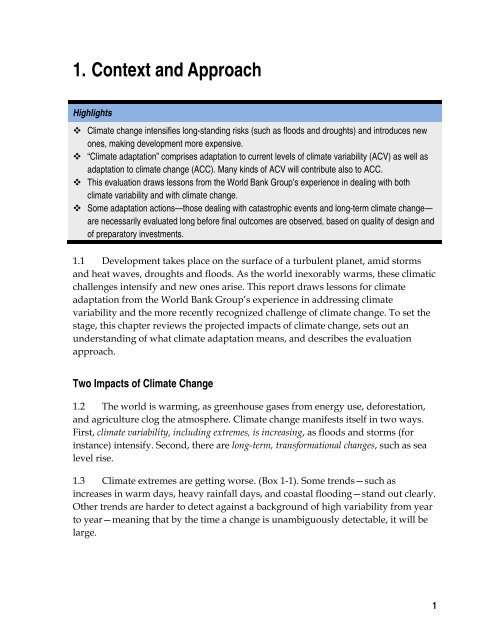Adapting to Climate Change: Assessing the World Bank Group ...
Adapting to Climate Change: Assessing the World Bank Group ...
Adapting to Climate Change: Assessing the World Bank Group ...
You also want an ePaper? Increase the reach of your titles
YUMPU automatically turns print PDFs into web optimized ePapers that Google loves.
1. Context and ApproachHighlights <strong>Climate</strong> change intensifies long-standing risks (such as floods and droughts) and introduces newones, making development more expensive. “<strong>Climate</strong> adaptation” comprises adaptation <strong>to</strong> current levels of climate variability (ACV) as well asadaptation <strong>to</strong> climate change (ACC). Many kinds of ACV will contribute also <strong>to</strong> ACC. This evaluation draws lessons from <strong>the</strong> <strong>World</strong> <strong>Bank</strong> <strong>Group</strong>’s experience in dealing with bothclimate variability and with climate change. Some adaptation actions—those dealing with catastrophic events and long-term climate change—are necessarily evaluated long before final outcomes are observed, based on quality of design andof prepara<strong>to</strong>ry investments.1.1 Development takes place on <strong>the</strong> surface of a turbulent planet, amid s<strong>to</strong>rmsand heat waves, droughts and floods. As <strong>the</strong> world inexorably warms, <strong>the</strong>se climaticchallenges intensify and new ones arise. This report draws lessons for climateadaptation from <strong>the</strong> <strong>World</strong> <strong>Bank</strong> <strong>Group</strong>’s experience in addressing climatevariability and <strong>the</strong> more recently recognized challenge of climate change. To set <strong>the</strong>stage, this chapter reviews <strong>the</strong> projected impacts of climate change, sets out anunderstanding of what climate adaptation means, and describes <strong>the</strong> evaluationapproach.Two Impacts of <strong>Climate</strong> <strong>Change</strong>1.2 The world is warming, as greenhouse gases from energy use, deforestation,and agriculture clog <strong>the</strong> atmosphere. <strong>Climate</strong> change manifests itself in two ways.First, climate variability, including extremes, is increasing, as floods and s<strong>to</strong>rms (forinstance) intensify. Second, <strong>the</strong>re are long-term, transformational changes, such as sealevel rise.1.3 <strong>Climate</strong> extremes are getting worse. (Box 1-1). Some trends—such asincreases in warm days, heavy rainfall days, and coastal flooding—stand out clearly.O<strong>the</strong>r trends are harder <strong>to</strong> detect against a background of high variability from year<strong>to</strong> year—meaning that by <strong>the</strong> time a change is unambiguously detectable, it will belarge.1

















